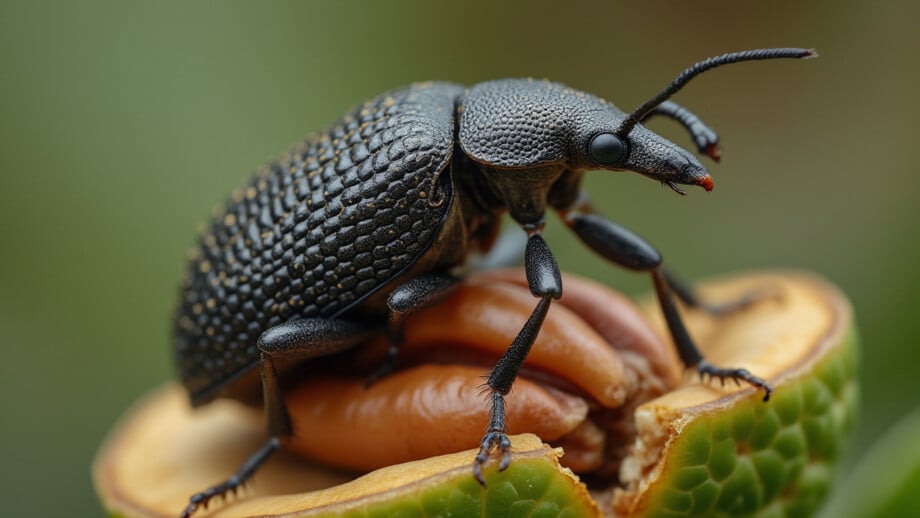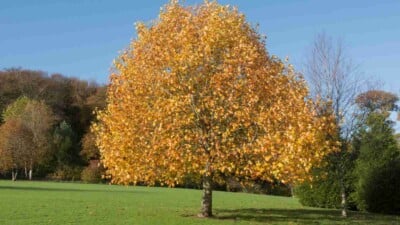Pecan Weevil
Learn how to identify and effectively control pecan weevils using time-tested, natural and organic treatments.

A serious late season pest of pecan and hickory trees, the pecan weevil (Curculio caryae) chews holes through the shuck and shell of nuts and are responsible for two kinds of damage.
The first type of damage is caused by adult weevils feeding on kernels prior to the shells hardening. Nuts punctured by weevils during this stage have a tobacco-juice-like stain around the feeding site. Damaged nuts often shrivel, turn black inside and drop prematurely.
The second type of damage occurs later in the growing season when females place eggs within the newly formed kernels. Larvae hatch and feed within the kernel causing further damage. These infested nuts do not drop and are often harvested along with a healthy crop. The pecan weevil causes serious economic loses wherever pecan and hickory trees are grown.
Identification
Adults are hard shelled beetles about 3/8 inch long with long slender snouts (females have a snout longer than their bodies) and thin legs. They are reddish brown in color and densely covered with olive-brown hairs and scales. Larvae are fat, creamy white, C-shaped grubs. They have reddish-brown heads and grow to 1/3 inch long.
Life Cycle
Adult weevils and larvae overwinter in the soil. The majority of adults emerge from the soil during August and the first week of September. When nuts reach the dough stage of development, mated females lay 2-4 eggs in separate pockets within the kernels. After eggs hatch, young legless larvae feed for about 30-35 days inside pecans. Between late September and December larvae exit nuts through a small circular hole, drop to the ground and burrow into the soil to a depth of 4-12 inches. They spend one to two years in the soil before pupating in the fall. (Most of the grubs will pupate the following fall. Although some do not pupate until the fall of the next year.) The pupal stage lasts about three weeks. Adults remain in the soil until the following summer. There is one generation every 2-3 years.
How to Control
- Spread in bands around the base of trees, Tanglefoot® Pest Barrier will prevent adult weevils from reaching the nuts on which they feed.
- Beneficial nematodes are microscopic, worm-like parasites that actively hunt, penetrate and destroy pecan weevil larvae in the soil. Applications should be made around the base of trees, out to the drip line — or a little farther.
- AzaMax contains azadirachtin, the key insecticidal ingredient found in neem oil. This broad spectrum, organic spray disrupts growth and development of pest insects and has repellent and antifeedant properties. Best of all, it’s non-toxic to honey bees and many other beneficial insects.
- BotaniGard ES is a highly effective biological insecticide containing Beauveria bassiana, an entomopathogenic fungus that attacks a long-list of troublesome crop pests – even resistant strains! Weekly applications can prevent insect population explosions and provide protection equal to or better than conventional chemical pesticides.
- Growers with only a few trees can place tarps under the canopy during August, especially several days after a rain, and jar the limbs to shake adults free. Weevils that fall will remain still for several minutes and can be collected and destroyed in a bucket of soapy water. This technique can be repeated until mid-September or until no weevils are found.
- Apply fast-acting botanical insecticides after 6 weevils are jarred from a single tree. Normally, three to five sprays every 5-7 days are required. These natural pesticides will also prevent egg laying by adults, if applied soon after adults emerge.
Note: Botanical insecticides — derived from plants which have insecticidal properties — have fewer harmful side effects and break down more quickly in the environment than synthetic chemicals.













